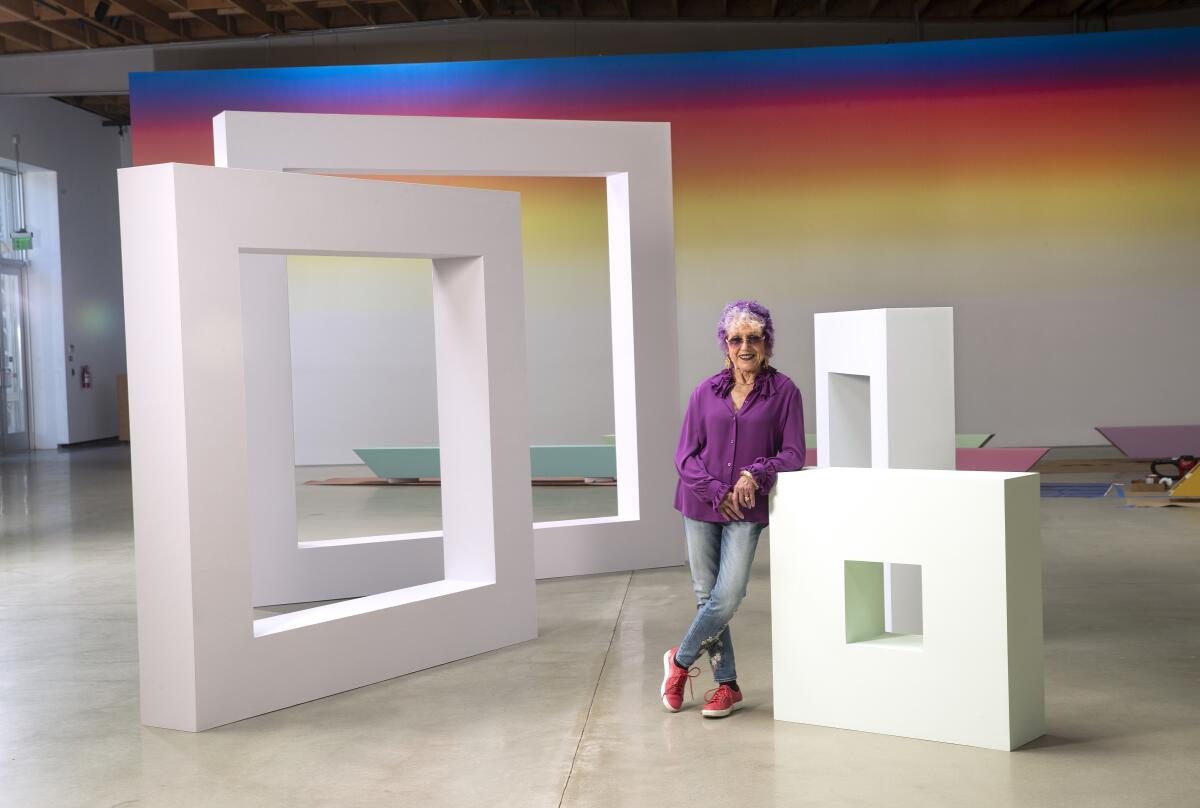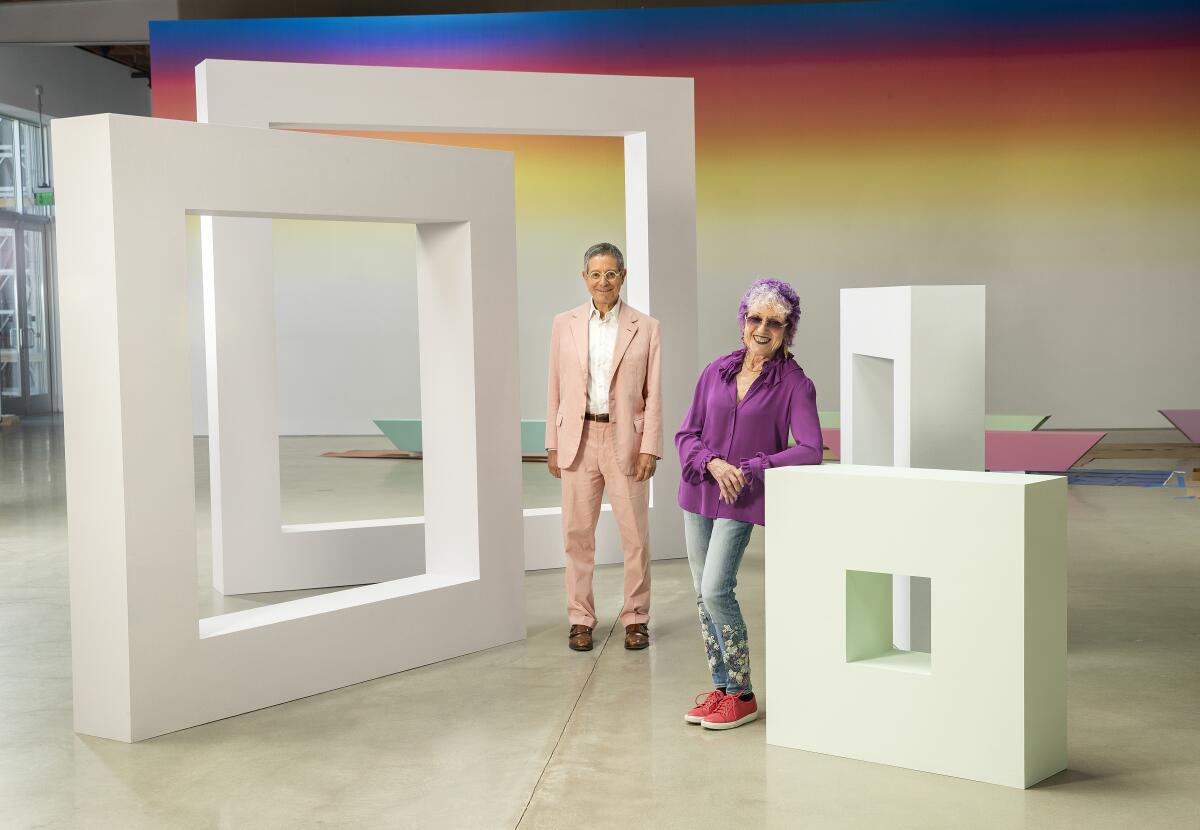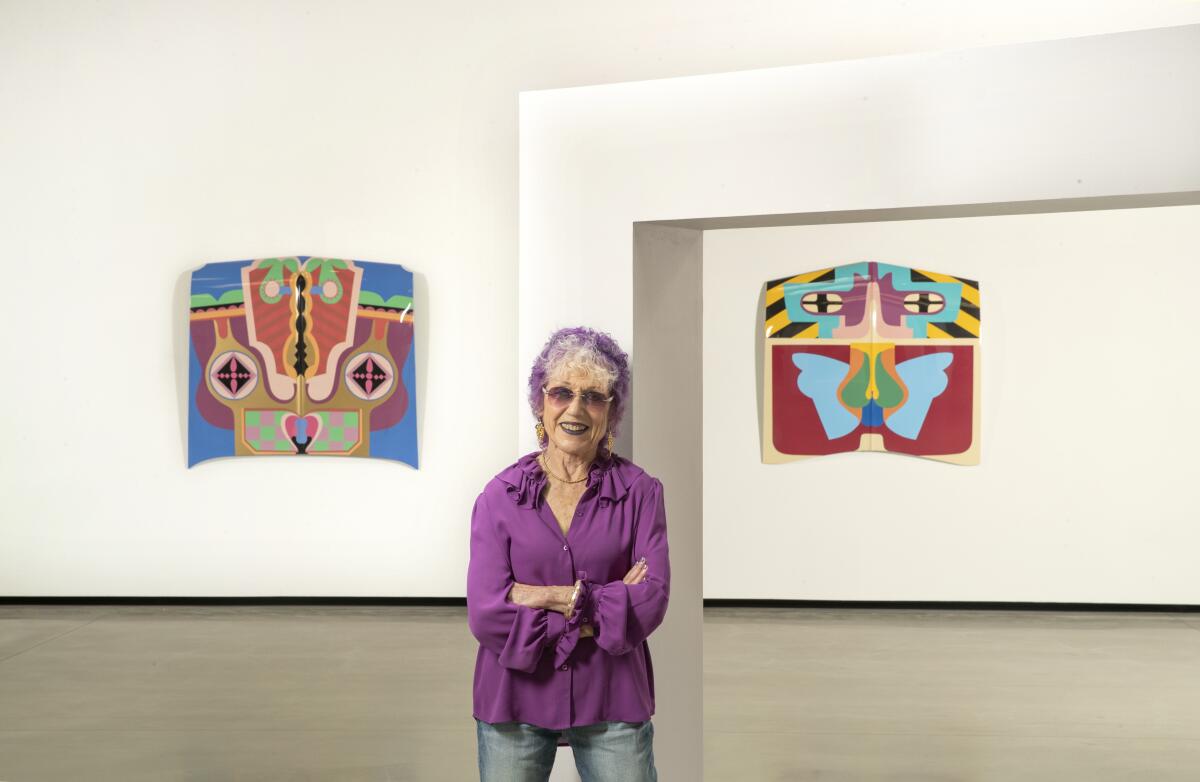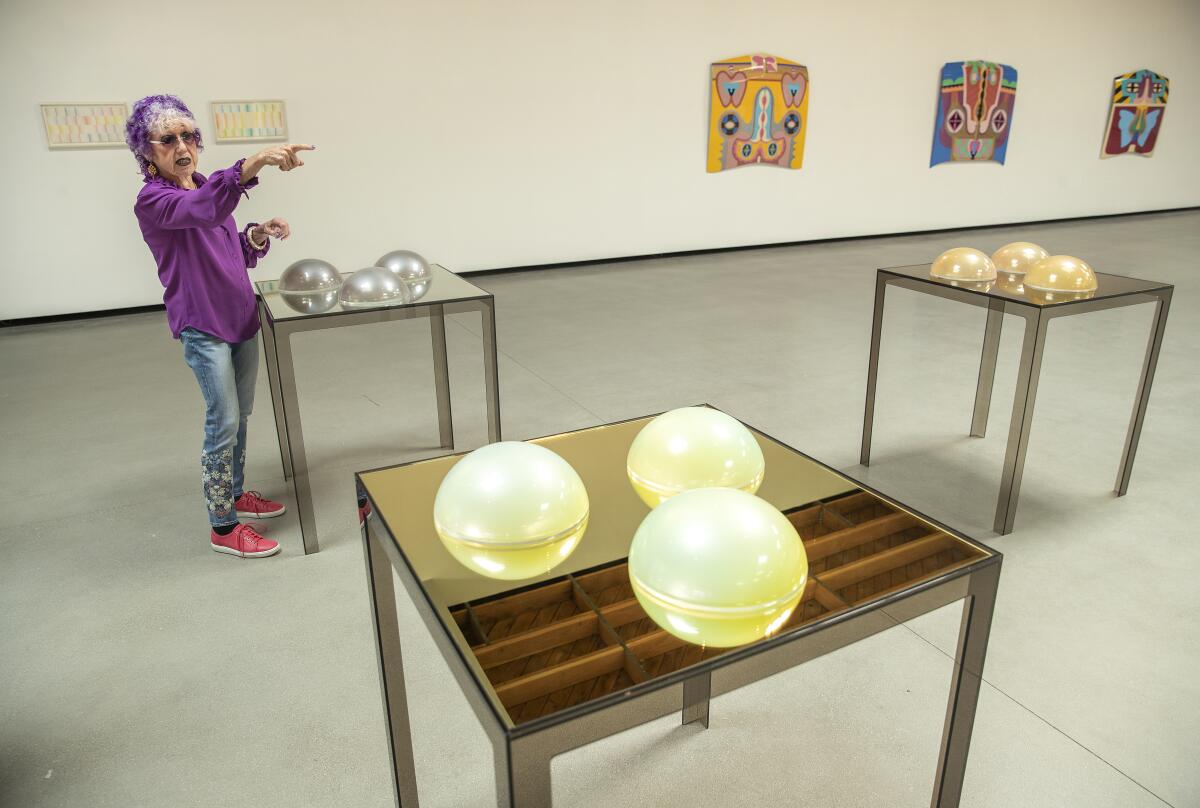Judy Chicago says, ‘I was being erased’ from Southern California art history

- Share via
There are musicians whose careers are made by a single song, authors whose writing is defined by a single novel. For much of her career, Judy Chicago’s work has been overshadowed by a single art piece: “The Dinner Party,” a large-scale 1979 installation that imagined a gathering of 39 important women sidelined by history.
Using the form of an elaborate banquet table with place settings that included hand-painted ceramic plates with designs inspired by female genitalia, the piece paid tribute to figures such as Hatshepsut, the 15th century B.C. Egyptian pharaoh; Artemisia Gentileschi, a 17th century Italian baroque painter; and Sacagawea, the Shoshone woman who guided explorers Lewis and Clark.
When “The Dinner Party” debuted at the San Francisco Museum of Modern Art in the spring of 1979, it immediately became a public sensation. (An estimated 100,000 people saw the work at SFMOMA in just three months.) It was just as quickly disparaged by critics. (“Crass and solemn and single-minded,” wrote Hilton Kramer in the New York Times.)
Still, the renown of “The Dinner Party,” now permanently installed at the Brooklyn Museum in New York, was lasting. It not only eclipsed Chicago’s later pieces — from “Birth Project,” a collaboration with more than 150 needleworkers, to this year’s “Purple Poem for Miami,” her most recent fireworks performance, which sent clouds of colorful smoke throughout Miami’s design district — but her early aesthetic innovations, developed as a young art student and artist in Los Angeles in the 1960s and ’70s.
“My formal language, my color language, my approach to art-making, I built it here,” she says, as she sits, radiant in purple shirt, purple hair and purple glasses at the Los Angeles gallery Jeffrey Deitch, where on a recent Friday afternoon she could be found installing an exhibition of her early work. “My roots were in Los Angeles. I felt very strongly about that.”
Born Judith Sylvia Cohen in 1939, Chicago arrived in Los Angeles in the late 1950s as an undergraduate at UCLA. In the ’60s, she ran with the famously macho artists of the Ferus Gallery, which included Billy Al Bengston, Edward Kienholz, Robert Irwin and Ed Moses.
But keeping up with that boys club was ultimately not for Chicago and the whole experience led her to rethink the nature of her work. “I was trying to make art that fit in,” she says. “At a certain point, I was like, ‘I’m not going to do that anymore.’”
In 1970, seven years after the death of her husband, Jerry Gerowitz, she took the surname “Chicago” as a way of dispensing with patronymics and as a nod to the city of her birth. She made the announcement before a solo show at Cal State Fullerton in an Artforum ad that became known as the “boxing ring ad”: “Judy Gerowitz hereby divests herself of all names imposed upon her through male social dominance and freely chooses her own name: Judy Chicago.”
She also turned her sights on arts education — helping establish feminist art programs at Cal State Fresno and the California Institute of the Arts, programs that changed not only the careers of the women who participated in them, but the nature of teaching art.
That era, with its tumult and its activism, was a fruitful time. After receiving her master’s at UCLA in 1964, Chicago took an auto body class and learned how to spray-paint. This propelled her in new directions, toward work that drew from the hard-edge geometries of minimalism but added a more buoyant color palette: brilliant blues, earthy greens and flesh tones that quiver with sensuousness.
A series titled “Pasadena Lifesavers,” from the late ’60s and early ’70s, depicts circles in jewel tones that could also serve as abstracted stand-ins for orifices. Another series made in Fresno, known as the “Fresno Fans,” are rigorous studies of color and geometric form that wink at feminine themes. They also reveal a painter who knows how to coax shape and shadow out of spray paint, a famously unforgiving material.
At the age of 80, the career of Judy Chicago is finally being revisited in its depth and its breadth. Last year, the Institute of Contemporary Art Miami featured a three-decade survey of her work. This month a new series by the artist, devoted to mortality and extinction, will go on view at the National Museum of Women in the Arts in Washington, D.C. And next spring the De Young Museum in San Francisco will host her first career retrospective.
That’s in addition to the show at Jeffrey Deitch, “Judy Chicago: Los Angeles,” which opens Saturday — and which for the first time reunites all of her early works, including “Pasadena Lifesavers” and the “Fresno Fans.”

“I was being erased from the history of Southern California art and it really upset me,” says the artist (who now lives in New Mexico). But the launch of the Pacific Standard Time series of exhibitions in 2011 helped resurface some of her early work. “It began the process of my larger body of work emerging from the shadow of ‘The Dinner Party.’”
In this conversation, which has been condensed and edited for clarity, Chicago talks about the early days — and how L.A. car culture influenced her art.
What prompted your decision to go to auto body school?
In the ’60s, I was showing at Rolf Nelson, one of the early galleries. He had come from New York. Virginia Dwan had opened. They were bringing artists to Los Angeles and one of those artists was John Chamberlain [known for producing sculptures of crushed cars].
John had a place in Topanga. Even though it was inhospitable, I hung out with the guys. I hung out with John. He would always say I should go to auto body school — those are the guys who know how to paint. I don’t know what made me decide to go to auto body school. I went right after I got my master’s.
What was it like?
There were 250 guys. I was the only woman. It was two months, intense, every day. They made me wear this long, white shop coat — don’t ask me why. Percy Jeffries was my teacher, a show car painter and he did striping. He was African American, tall, very handsome. Drove a candy-apple pale lavender convertible. Percy said, “There is no perfection, there is only the illusion of perfection.”
They start with basic stuff: taping, preparing, masking, mixing paint, spraying paint. I think that was when I discovered spray paint — the idea of merging color and surface, I was hooked. I never liked oil paint, I never liked imposing on the surface. But there was something about spraying. I sprayed all through the ’60s. I’ve sprayed paper and plastic. I’ve sprayed canvas. I’ve sprayed china. I’ve sprayed glass.
I studied art from the time I was 5. The emphasis was always on drawing skills and expression. When I went to auto body school, it was the first time I sort of realized that in making paintings or sculptures, I was making objects, physical objects.
Were you into car culture?
I thought they were beautiful, but no. For me, it was something else. It was a pathway to approach making art.
Still, you were taking an aspect of car culture — the sexy woman on the hood — and saying, “I’m going to put a woman on a hood but make it feminist.”
They had pinups all over auto body school. It was part of car culture. I just didn’t pay attention to it. These three — [she gestures at three painted car hoods in the gallery, whose patterns are inspired, in part, by the forms of female anatomy] — I laid them out in the ’60s, but I didn’t do them until much later. I was getting so much [grief] for my color and my forms. “Bigamy Hood,” “Birth Hood” and “Flight Hood” — they come from paintings I did in graduate school. I destroyed them because my instructors hated my imagery and my color.

Which instructors were those?
I went to UCLA at the time. The artist who predominated in terms of UCLA was Rico Lebrun. He was a painter. His palette ran to burnt umber, yellow ocher, burnt sienna, olive green. That’s how they all painted at UCLA. They all painted in that palette. And then there’s me: I like ivory and turquoise and pink and lavender.
They hated my colors — just hated them. And that’s why I moved away from color for a while. So, if I tie my hand behind my back on color, how can I make visually arresting forms? None of that was lost. All of those years contributed to who I became.
How did you arrive at the colors you use?
It is just my natural palette. I did a lot of color studies. When I was doing studies, I would lay out my color and then I would say, “I wonder what would happen if I move the yellow ocher over or the pink over.” And then I’d have to do another drawing. And, “what if I substituted blue for this?” So I did dozens and dozens of drawings. The Getty Research Institute owns my color book. [I wanted to build] a color vocabulary built on emotive associations.
How else would you say that your time in Southern California shaped your work?
There are two other ways. The art scene was so nascent here — there was no international art market, nobody thought you’d make a fortune as an artist. The idea was to be taken seriously as an artist. This was really important. People who say, “Aren’t you upset it’s taken so long to be taken seriously?” And I say, “No! I’ve had six decades of being in the studio. Making art is what’s important to me.” The idea of that, that’s very L.A.

The other aspect is that there was a spirit of self-invention here. There was a ‘go f— yourself’ attitude too. There is the famous story of the Ferus boys who were at the homes of the Factors — Bonnie Factor. They had this sunken living room that was filled with white furniture. And this New York critic, Max Kozloff, he sees them in the living room and says, “It looks like a scene from Delacroix!” And Billy Al [Bengston] turns around and says, “Who the f— was Delacroix?”
That attitude toward authority, that shaped me. I always say, how would I have ever in New York imagined that I could create a feminist art practice or a feminist art education? That came out of the spirit of here.
'Judy Chicago: Los Angeles'
More to Read
The biggest entertainment stories
Get our big stories about Hollywood, film, television, music, arts, culture and more right in your inbox as soon as they publish.
You may occasionally receive promotional content from the Los Angeles Times.











